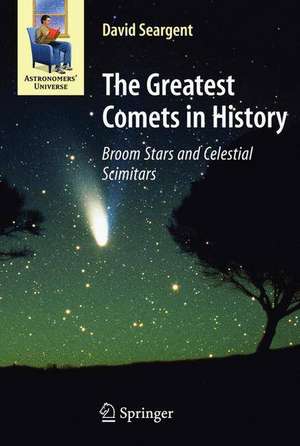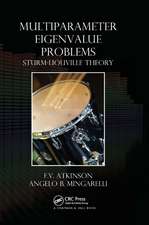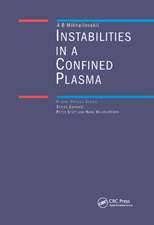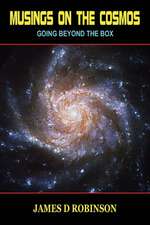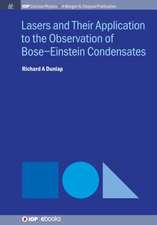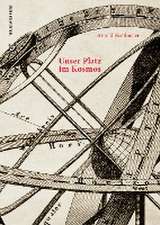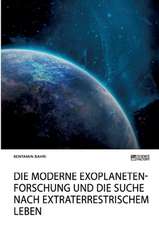The Greatest Comets in History: Broom Stars and Celestial Scimitars: Astronomers' Universe
Autor David A.J. Seargenten Limba Engleză Paperback – 13 noi 2008
Din seria Astronomers' Universe
-
 Preț: 210.44 lei
Preț: 210.44 lei -
 Preț: 207.15 lei
Preț: 207.15 lei -
 Preț: 195.53 lei
Preț: 195.53 lei -
 Preț: 254.90 lei
Preț: 254.90 lei -
 Preț: 284.56 lei
Preț: 284.56 lei -
 Preț: 212.88 lei
Preț: 212.88 lei -
 Preț: 256.41 lei
Preț: 256.41 lei -
 Preț: 264.35 lei
Preț: 264.35 lei -
 Preț: 259.08 lei
Preț: 259.08 lei -
 Preț: 227.61 lei
Preț: 227.61 lei -
 Preț: 277.98 lei
Preț: 277.98 lei -
 Preț: 305.70 lei
Preț: 305.70 lei -
 Preț: 253.11 lei
Preț: 253.11 lei -
 Preț: 216.60 lei
Preț: 216.60 lei -
 Preț: 272.24 lei
Preț: 272.24 lei -
 Preț: 330.75 lei
Preț: 330.75 lei -
 Preț: 179.00 lei
Preț: 179.00 lei -
 Preț: 289.83 lei
Preț: 289.83 lei -
 Preț: 160.03 lei
Preț: 160.03 lei -
 Preț: 200.80 lei
Preț: 200.80 lei -
 Preț: 255.97 lei
Preț: 255.97 lei -
 Preț: 242.58 lei
Preț: 242.58 lei -
 Preț: 262.55 lei
Preț: 262.55 lei -
 Preț: 282.38 lei
Preț: 282.38 lei -
 Preț: 187.82 lei
Preț: 187.82 lei -
 Preț: 225.19 lei
Preț: 225.19 lei -
 Preț: 207.64 lei
Preț: 207.64 lei -
 Preț: 104.35 lei
Preț: 104.35 lei -
 Preț: 188.94 lei
Preț: 188.94 lei -
 Preț: 270.49 lei
Preț: 270.49 lei -
 Preț: 212.01 lei
Preț: 212.01 lei -
 Preț: 169.08 lei
Preț: 169.08 lei -
 Preț: 210.01 lei
Preț: 210.01 lei -
 Preț: 208.26 lei
Preț: 208.26 lei -
 Preț: 253.98 lei
Preț: 253.98 lei -
 Preț: 180.12 lei
Preț: 180.12 lei -
 Preț: 273.13 lei
Preț: 273.13 lei -
 Preț: 207.39 lei
Preț: 207.39 lei -
 Preț: 208.70 lei
Preț: 208.70 lei -
 Preț: 214.86 lei
Preț: 214.86 lei -
 Preț: 188.94 lei
Preț: 188.94 lei -
 Preț: 194.65 lei
Preț: 194.65 lei -
 Preț: 277.34 lei
Preț: 277.34 lei -
 Preț: 187.15 lei
Preț: 187.15 lei -
 Preț: 210.93 lei
Preț: 210.93 lei -
 Preț: 212.01 lei
Preț: 212.01 lei
Preț: 280.19 lei
Nou
Puncte Express: 420
Preț estimativ în valută:
53.61€ • 55.98$ • 44.37£
53.61€ • 55.98$ • 44.37£
Carte disponibilă
Livrare economică 15-29 martie
Preluare comenzi: 021 569.72.76
Specificații
ISBN-13: 9780387095127
ISBN-10: 0387095128
Pagini: 284
Ilustrații: XX, 260 p. 47 illus., 8 illus. in color.
Dimensiuni: 155 x 235 x 17 mm
Greutate: 0.45 kg
Ediția:1st Edition.2nd Printing. 2008
Editura: Springer
Colecția Springer
Seria Astronomers' Universe
Locul publicării:New York, NY, United States
ISBN-10: 0387095128
Pagini: 284
Ilustrații: XX, 260 p. 47 illus., 8 illus. in color.
Dimensiuni: 155 x 235 x 17 mm
Greutate: 0.45 kg
Ediția:1st Edition.2nd Printing. 2008
Editura: Springer
Colecția Springer
Seria Astronomers' Universe
Locul publicării:New York, NY, United States
Public țintă
Popular/generalCuprins
The Nature of Comets.- Halley#x2019;s Comet Through the Ages.- The Greatest Comets of Ancient Times.- The Greatest Comets from A.D. 1000 to 1800.- The Greatest Comets from 1800 to Present Times.- Kamikaze Comets: The Kreutz Sungrazers.- Daylight Comets.
Recenzii
From the reviews:
"This book is exactly what it says on the cover … . There are detailed accounts of how the comets would have appeared and changed during their appearance … and an analysis of the comments and drawings they made at the time of observing. … anyone who has an interest in astronomy could easily read this book. I imagine it would appeal particularly to those who are interested in astronomical history and in particular comets." (David Bowdley, Astronomy Now, June, 2009)
"For those with an historical interest in comets, this is a compelling book in that it succinctly presents an overview of almost fifty truly amazing comets … . The Greatest Comets in History … is an excellent book. It is totally affordable, and belongs in the library of all those with a passion for comets and cometary history." (Wayne Orchiston, Journal of Astronomical History and Heritage, Vol.12 (1), 2009)
"In this small book, Seargent … gives observational details about his favorite comets from ancient times through the present. … the book provides comet descriptions in chronological order. Photographs and artwork illustrate some comets. … volume includes a short glossary, suggested readings, and a tabular list of the ‘greatest’ comets. Readers with an avid interest in comets will value the completeness and detail of this work … . Summing Up: Recommended. All levels of general readers, undergraduates interested in the history of astronomy, and professionals." (M. Dickinson, Choice, Vol. 46 (11), July, 2009)
“The author’s wonderful descriptions of the spectacular comets that have been given the moniker of “Great”, I wish that I could have personally witnessed all of them. … I thoroughly enjoyed the author’s writing style and the way he has presented this material. I highly recommend this book to anyone interested in observing comets or reading about this aspect of astronomical history.” (A. Robert, The Observatory, Vol.130 (1214), February, 2010)
"This book is exactly what it says on the cover … . There are detailed accounts of how the comets would have appeared and changed during their appearance … and an analysis of the comments and drawings they made at the time of observing. … anyone who has an interest in astronomy could easily read this book. I imagine it would appeal particularly to those who are interested in astronomical history and in particular comets." (David Bowdley, Astronomy Now, June, 2009)
"For those with an historical interest in comets, this is a compelling book in that it succinctly presents an overview of almost fifty truly amazing comets … . The Greatest Comets in History … is an excellent book. It is totally affordable, and belongs in the library of all those with a passion for comets and cometary history." (Wayne Orchiston, Journal of Astronomical History and Heritage, Vol.12 (1), 2009)
"In this small book, Seargent … gives observational details about his favorite comets from ancient times through the present. … the book provides comet descriptions in chronological order. Photographs and artwork illustrate some comets. … volume includes a short glossary, suggested readings, and a tabular list of the ‘greatest’ comets. Readers with an avid interest in comets will value the completeness and detail of this work … . Summing Up: Recommended. All levels of general readers, undergraduates interested in the history of astronomy, and professionals." (M. Dickinson, Choice, Vol. 46 (11), July, 2009)
“The author’s wonderful descriptions of the spectacular comets that have been given the moniker of “Great”, I wish that I could have personally witnessed all of them. … I thoroughly enjoyed the author’s writing style and the way he has presented this material. I highly recommend this book to anyone interested in observing comets or reading about this aspect of astronomical history.” (A. Robert, The Observatory, Vol.130 (1214), February, 2010)
Notă biografică
David Seargent is a former lecturer in Philosophy with the Department of Community Programs at the University of Newcastle in Australia and is now a full-time writer. He is the author of the very popular Comets: Vagabonds of Space (Doubleday), formerly a contributing editor on comets to Sky & Space magazine, and currently author of the regular comet column for Australian Sky & Telescope (the southern hemisphere edition). He was co-author with Joseph Marcus, of a paper published in 1986 entitled "Dust forward scatter brightness enhancement in previous apparitions of Halley’s comet" (Proceedings, 20th. ESLAB Symposium on the Exploration of Halley’s Comet, Vol. 3, B. Battrick, E. J. Rolfe and R. Reinhard, eds. ESA SP-250. European Space Agency Publications). He was also the Australian co-ordinator for visual observations during the International Halley Watch, 1985-6.
Textul de pe ultima copertă
Comets have fascinated and awed humankind since ancient times. Of the thousands of comets recorded throughout history, those deemed to have been the most spectacular have been described in the accounts of eyewitnesses and often recorded in official documents.
This book introduces you to the greatest of the greats, starting with the comet in 372 B. C. called "Aristotle’s Comet" and ending with the spectacular appearance of McNaught’s Comet in 2007. There is an introductory chapter explaining what comets are and how they are classified, and correcting a few popular misconceptions. Later in the book you will read about the different returns of Halley’s Comet and the Kreutz sungrazing group, often called the kamikaze comets. There is even a chapter on comets that were visible in broad daylight.
This book is unique. There are a few books on comets that make passing reference to some of the more famous or spectacular objects of the past, and a few catalogs with long lists of comets. But little detailed and descriptive information is contained in either of these sources.
This is a fascinating account, not only for astronomers at every level but also for readers of popular science. In an engaging way it pulls together a vast amount of information and offers rich anecdotal material that will entertain as well as inform you.
This book introduces you to the greatest of the greats, starting with the comet in 372 B. C. called "Aristotle’s Comet" and ending with the spectacular appearance of McNaught’s Comet in 2007. There is an introductory chapter explaining what comets are and how they are classified, and correcting a few popular misconceptions. Later in the book you will read about the different returns of Halley’s Comet and the Kreutz sungrazing group, often called the kamikaze comets. There is even a chapter on comets that were visible in broad daylight.
This book is unique. There are a few books on comets that make passing reference to some of the more famous or spectacular objects of the past, and a few catalogs with long lists of comets. But little detailed and descriptive information is contained in either of these sources.
This is a fascinating account, not only for astronomers at every level but also for readers of popular science. In an engaging way it pulls together a vast amount of information and offers rich anecdotal material that will entertain as well as inform you.
Caracteristici
Written for astronomers of all levels – from interested “armchair” astronomers to professionals and History of Astronomy students Gathers together descriptive information on major historical comets that is not readily available elsewhere Gives a good comparison between recent comets and their older counterparts Contains a wealth of interesting facts not found in regular astronomy books
